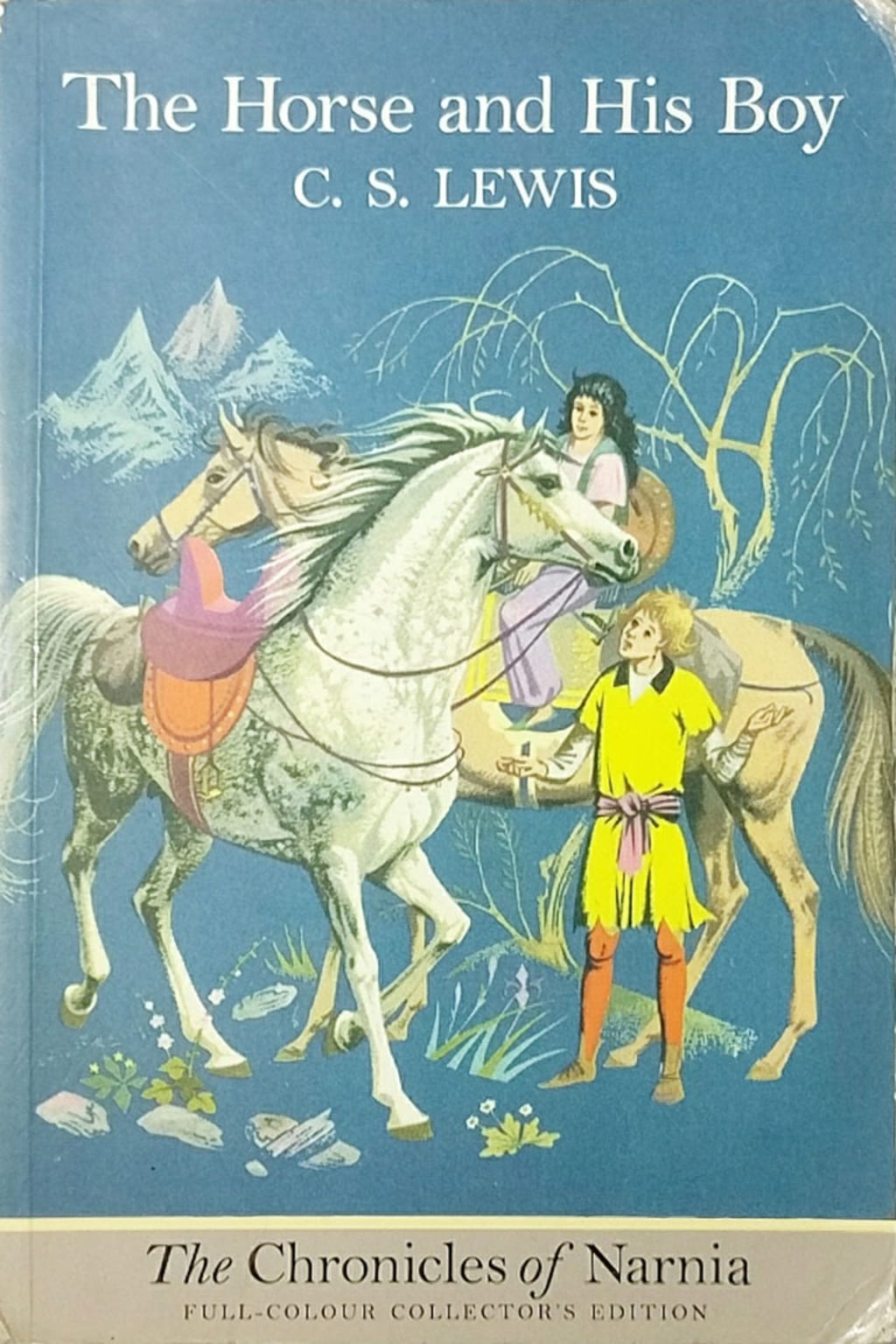The Horse and His Boy Review
Let's take a look at a controversial classic.

Does the 5th entry in the legendary Chronicles of Narnia series stood the test of time with its premise of childhood escapism? Or does its writing and controversial topics makes it worthy of an H.P. Lovecraft seal? Let's take a look.
Plot
The novel tells the tale of a young teenage boy named Shashta, who lived his whole life as a fisherman in Calormen, together with his old (and sometimes abusive) father named Arsheesh. One day, a nobleman rode into the fisherman's hut looking for hospitality,. While staying, the nobleman offered to buy Shashta as a servant, and we later learn that Shashta is in fact, adopted. The young boy was excited at first to finally leave his hut and live under the care of the nobleman. However, the nobleman's horse suddenly started talking to him, warning him of the cruelty this nobleman possessed. This horse is no ordinary horse. His name is Bree and he is a Narnian who was kidnapped to become this man's war horse.
The two then decided to run away together to Narnia, the land of the free. On the way, they later meet other runaways like a Calormen girl named Aravis and her own talking horse Hwin. Soon, the group discovers a deep conspiracy in the city of Tashbaan, a plan which would bring war between Narnia and Calormen. Now, they must race North in order to warn everyone and stop this impending conflict.
Unlike the other entries in the series, The Horse and His Boy is written more like a side-story for expanding the Narnian universe. Nonetheless, it still brings that classic C.S. Lewis adventure story that everyone loves. The Horse And His Boy follows the traditional hero's journey, but like The Lion, The Witch, and The Wardrobe, it's basically written as an escapist fiction for the younger audience. Shashta parallels that of modern young adult fantasy characters like Harry Potter and Percy Jackson. And like them, he's also written specially for kids who too dreams of finally leaving their homes and going on epic quests.
As an adventure novel, The Horse and His Boy will take you to a lot of grand places, from bustling cities, unforgiving deserts to spring-time forests. Every surrounding was described and envisioned well by C.S. Lewis, from the large structures and the dangers they hold, down to its little inhabitants below. The only criticism I have of the book is that, unlike other novels in the series, the story likes to take its time. Anyone who's hungry for that awesome C.S. Lewis battles, will be disappointed after having to slog through 9 chapters that have little to no action.
Characters
I fell in love with Shashta after reading the book. Unlike other modern day teenager protagonists like Katniss Everdeen for example, Shashta is not the most talented (and overpowered) character in his story. This makes him a realistic protagonist to follow, one who learns and fails things the first few times he does them (like riding). He's not one who shies away from crying too when a soldier smacks him in the face in the earlier chapters (he is a kid afterall). But by the later chapters, we start to see Shashta evolve from a naive little boy to a brave battlefield warrior.
The titular horse of the story, Bree, is also entertaining. He's your typical wisdom-carrying mentor to Shashta. An interesting aspect I noticed of Bree is his love of combining gentle words with sarcasm, an understandable element knowing this is a British novel filled with dry British humor. On the other hand, the problem I have with Bree is that he isn't given much character development besides his budding relationship with Shashta. After all, he is already a wise old horse in the beginning of the novel, and I kind of suspect C.S. Lewis wrote him as a metaphor for "kids who needs to listen to adults more".
Aravis is also a character that I fell in love with. She's a badass female character who really embodies the "strong independent woman" stereotype without the need to be woke. Her story starts off as every little girl's nightmare of being forced to marry an old geezer by her family. After Aravis runs away and meets Shasta, we later learn how much she's better in riding, sneaking and fighting than the boy. That being said, her character doesn't go too far into "borders of woman's superiority" since even though she's a tough dame, Shashta ends up being her more humane voice of reason.
The main antagonist however, Prince Rabadash, is the weakest link in the story. He is your typical spoiled Joeffrey-style brat, who likes to get everything he wants. The role of the antagonist in the story is to give conflict and purpose to the protagonist, but here, Rabadash is nothing but a wimp. He gets easily wrecked in the final battle, resulting in an anticlimactic end to the story. I feel like more character could have been put into his personality, but I guess C.S. Lewis didn't plan on making any terrifically relatable villain, or a more dangerous one at that. He only wanted an easy to hate and easy to beat villain for the story.
Writing
This is where I had the most problems with the book and C.S. Lewis's writing as a whole. His writings have always been okay but somewhat weird to read. First things first is his omniscient narrator-style of writing. Almost everything is explained to you rather than be presented, failing to follow the writer's golden rule of show-don't-tell. Everything from an event that happened in the past, an event currently happening now, or a hidden character trait, are sometimes lazily injected in the paragraph. At one point, Lewis even breaks the fourth wall and compares Calormen story-telling to essay-writing in English boarding schools.
The grammar and sentence structure are also something to criticize about. Like Frank Miller's abuse of emphasis in his writings, C.S. Lewis likes to abuse the term "and" in his. Like seriously, he uses the word too damn much, at one point I counted three being used in the same sentence. Instead of using commas or semi-colons, C.S. Lewis is addicted to using that word. I know some of you might not understand, but take a look at this paragraph right here:
"Then of course everyone stopped scolding Shasta and asking him questions and he was made much of and laid on a sofa and cushions were put under his head and he was given iced sherbet in a golden cup to drink and told to keep very quiet."
No commas, no periods, nothing. Take a shot of mojito tequila after every "and" in that paragraph and I guarantee you're gonna have a headache.
Controversy
Okay, since this is a 1960s C.S. Lewis book, it's time to mention the big elephant in the room. Was The Horse and His Boy racist to Muslims? As someone who grew up in Malaysia as a Muslim, I can say that... No it's not. You can see the similarities between Muslim civilizations and the Calormen, like their turbans, brown skin and scimitars. But to say that its racist to Muslims kind of downplays the fact that Lewis praised and glorified the Calormen many times in the book, especially how he described the magnificence of Tashbaan. Of course, there's also the authoritarian monarchy, conquering and enslavement, and gender inequality in Calormen traditions, but to say its racist is wrong since a lot of Muslim civilizations also did it. The Arabs back then enslaved people, the Ottoman Turks conquered and committed genocide, and today Iran is being criticized for its treatment of women.
However, there's no denying the fact that Lewis himself did not acknowledge that Christians has also made a lot of these horrible stuffs back then. The story of Aslan triumphing against the Calormen army (who worshiped the god Tash), is a big middle finger with the words "Hey my god is better than yours" from Lewis. But in the end, I see all of this more as bias than racism.
Final Verdict
Even with the wacky writing and obvious Christian bias, The Horse and His Boy is still a fantastic read. All of the criticisms I have of it fizzled out as I focused more on Shashta's growth and survival. C.S. Lewis is a gifted story-teller and he knows how to portray young characters well (far better than the Mary Sues most modern YA authors tend to write). His young characters are ones who can grow on their own but not close-minded in asking help from the experienced adults. I would even argue that its world-building is a step-higher than the previous books, as we get to equally explore Narnia and its neighboring countries (rather than just focusing on the former).
Overall, it's a good adventure book. If you are one who likes fantasy, cleverly written teenage characters, and a well-written mythology to boot, then this book is for you. If you want to buy this book, buy the one with the beautiful illustrations from Pauline Baynes. That book is going to really suck you in.
About the Creator
Carl Hannigan
Self-acclaimed connoisseur of the literary arts. Famed warlord in the wars against typos. Lover of the sweet books and magnificent prints. TL;DR I'm a book nerd and editor :D






Comments
There are no comments for this story
Be the first to respond and start the conversation.